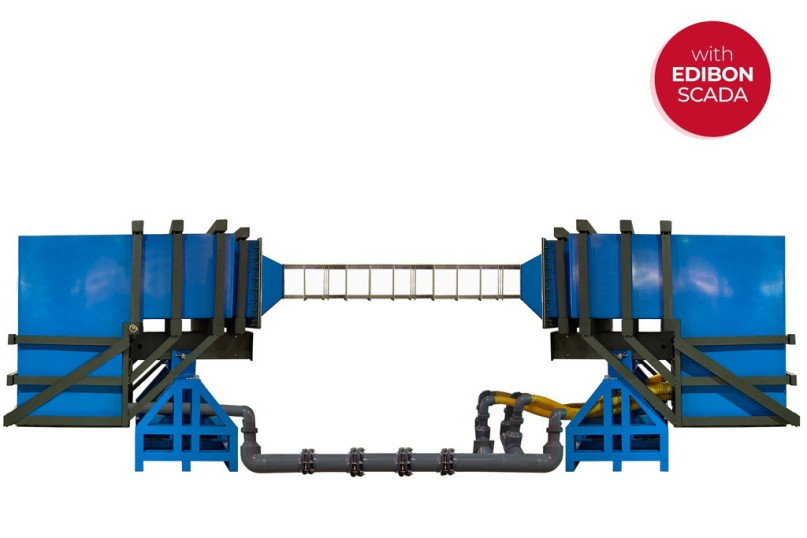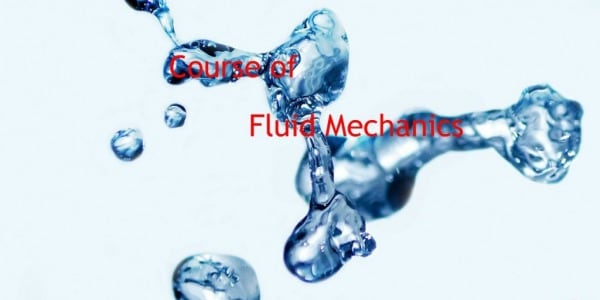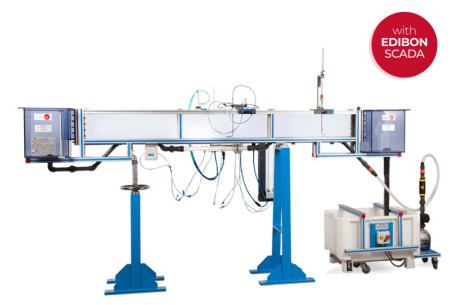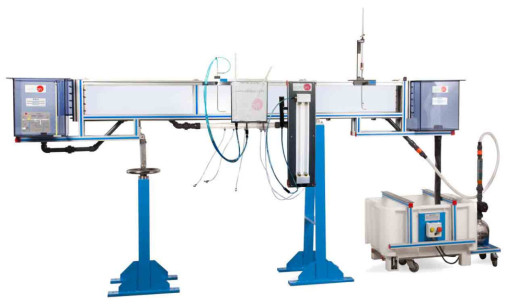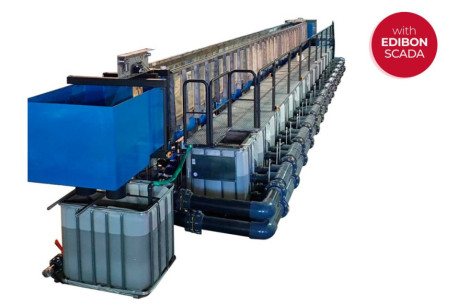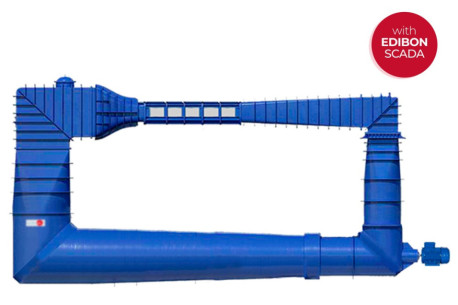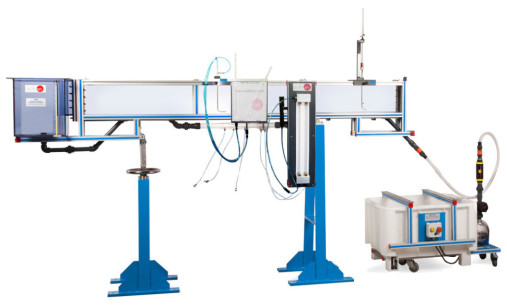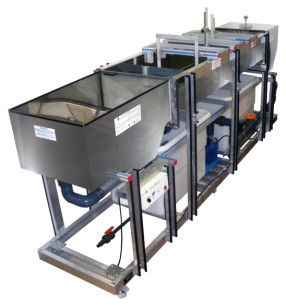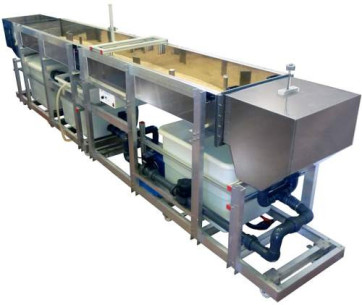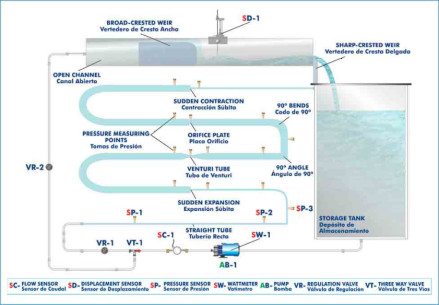Are you a teacher or do you work as an engineering researcher? EDIBON offers courses for teachers and #research staff. Take a look at the course of Fluid Mechanics and learn about #fluids properties. #DiscoverEdibon #Engineering.
HTLS150/150C Computer Controlled Closed Hydrodynamic Tunnel for Low Speed, 150X150 mm
INNOVATIVE SYSTEMS
The Computer Controlled Closed Hydrodynamic Tunnel for Low Speed, 150 x 150 mm, "HTHS150/150C", allows to test the hydrodynamics of bodies designed to work submerged in water and, with a correct design of the experiment, to study the aerodynamics of objects flying in air.
RELATED NEWS
General Description
The Computer Controlled Low Speed Hydrodynamic Tunnel, 150 x 150 mm, "HTLS150/150C", is a hydrodynamic tunnel in a closed water circuit flowing in the vertical plane. The water is circulated by a computer controlled variable speed pump. Different models and accessories are available, allowing a complete study of the hydrodynamics.
The unit includes several sections to reduce flow interference.
The working area consists of a constant section section, where the models are mounted for testing. It is manufactured with fused silica (quartz) windows on the front, back and top face for optical testing. This section includes a Pitot tube in its upper part to study static pressure, dynamic pressure and total pressure. It also includes a removable screen at the inlet to increase the turbulence of the flow.
This Computer Controlled Unit is supplied with the EDIBON Computer Control System (SCADA), and includes: The unit itself + a Control Interface Box + a Data Acquisition Board + Computer Control, Data Acquisition and Data Management Software Packages, for controlling the process and all parameters involved in the process.
Exercises and guided practices
GUIDED PRACTICAL EXERCISES INCLUDED IN THE MANUAL
- Extensive study of hydrodynamics and water flow studies.
- Study of flow visualization.
- Study of static pressure, dynamic pressure and total pressure using a Pitot tube.
- Study of the measurement of velocity using a Pitot tube.
- Study of turbulent and laminar flow.
- Study of cavitation in different models.
- Calibration of sensors.
MORE PRACTICAL EXERCISES TO BE DONE WITH THE UNIT
Additional practical possibilities to be carried out with the recommended additional elements (Not included):
- Visualization of flows around different resistor bodies:
- Sphere Drag Model (HTLS7/150) (requires element HTLS150/150C-TARC).
- Hemisphere Drag Model (HTLS8/150) (requires element HTLS150/150C-TARC).
- Circular Plate Drag Model (HTLS9/150) (requires element HTLS150/150C-TARC).
- Ring Drag Model (HTLS10/150) (requires element HTLS150/150C-TARC).
- Square Plate Drag Model (HTLS11/150) (requires element HTLS150/150C-TARC).
- Cylinder Drag Model (HTLS12/150) (requires element HTLS150/150C-TARC).
- Paraboloid Drag Model (HTLS13/150) (requires element HTLS150/150C-TARC).
- Dimpled Sphere Drag Model (HTLS14/150) (requires element HTLS150/150C-TARC).
- Wing Drag Model (HTLS15/150) (requires element HTLS150/150C-TARC).
- Airplane Drag Model (HTLS16/150) (requires element HTLS150/150C-TARC).
- Determination of the hydrodynamic drag coefficient and lift coefficient in different models:
- Sphere Drag Model (HTLS7/150) (requires element HTLS150/150C-TARC).
- Hemisphere Drag Model (HTLS8/150) (requires element HTLS150/150C-TARC).
- Circular Plate Drag Model (HTLS9/150) (requires element HTLS150/150C-TARC).
- Ring Drag Model (HTLS10/150) (requires element HTLS150/150C-TARC).
- Square Plate Drag Model (HTLS11/150) (requires element HTLS150/150C-TARC).
- Cylinder Drag Model (HTLS12/150) (requires element HTLS150/150C-TARC).
- Paraboloid Drag Model (HTLS13/150) (requires element HTLS150/150C-TARC).
- Dimpled Sphere Drag Model (HTLS14/150) (requires element HTLS150/150C-TARC).
- Wing Drag Model (HTLS15/150) (requires element HTLS150/150C-TARC).
- Airplane Drag Model (HTLS16/150) (requires element HTLS150/150C-TARC).
- Measurement of hydrodynamic drag and lift forces in different models:
- Sphere Drag Model (HTLS7/150) (requires element HTLS150/150C-TARC).
- Hemisphere Drag Model (HTLS8/150) (requires element HTLS150/150C-TARC).
- Circular Plate Drag Model (HTLS9/150) (requires element HTLS150/150C-TARC).
- Ring Drag Model (HTLS10/150) (requires element HTLS150/150C-TARC).
- Square Plate Drag Model (HTLS11/150) (requires element HTLS150/150C-TARC).
- Cylinder Drag Model (HTLS12/150) (requires element HTLS150/150C-TARC).
- Paraboloid Drag Model (HTLS13/150) (requires element HTLS150/150C-TARC).
- Dimpled Sphere Drag Model (HTLS14/150) (requires element HTLS150/150C-TARC).
- Wing Drag Model (HTLS15/150) (requires element HTLS150/150C-TARC).
- Airplane Drag Model (HTLS16/150) (requires element HTLS150/150C-TARC).
- Study of static pressure, dynamic pressure and total pressure with the Pitot tube (HTLS11/150).
- Study of the static pressure, dynamic pressure and total pressure with the Wake Survey Rake (HTLS12/150).
Other possibilities to be done with this unit:
- Many students view results simultaneously. To view all results in real time in the classroom by means of a projector or an electronic whiteboard.
- Open Control, Multicontrol and Real Time Control. This unit allows intrinsically and/or extrinsically to change the span, gains, proportional, integral, derivate parameters, etc, in real time.
- The Computer Control System with SCADA and allow a real industrial simulation.
- This unit is totally safe as uses mechanical, electrical and electronic, and software safety devices.
- This unit can be used for doing applied research.
- This unit can be used for giving training courses to Industries even to other Technical Education Institutions.
- Control of the HTLS150/150C unit process through the control interface box without the computer.
- Visualization of all the sensors values used in the HTLS150/150C unit process.
- Several other exercises can be done and designed by the user.
SUPPLEMENTARY EQUIPMENT
8.5.- HYDRAULIC CHANNELS
CFC
Channel, through which water flows, of rectangular section with transparent walls that enable to observe all the experiments. Water is taken from the storage tank by means of a hydraulic pump, with speed regulation, and, by the pipe, it is driven...
8.5.- HYDRAULIC CHANNELS
CF
Flow Channels (section: 80X300 mm)
Channel, through which water flows, of rectangular section with transparent walls that enable to observe all the experiments. Water is taken from the storage tank by means of a hydraulic pump and, by the pipe, it is driven to the inlet tank, where...
8.5.- HYDRAULIC CHANNELS
CFGC
Computer Controlled Flow Channels
The Computer Controlled Flow Channels, "CFGC", are hydrodynamic channels to perform multiple hydraulic tests. They consist of a rectangular section channel with tempered glass transparent walls through which water flows. Water is impelled by a...
8.5.- HYDRAULIC CHANNELS
CFG
Flow Channels
The Flow Channels, "CFG", are hydrodynamic channels to perform multiple hydraulic tests. They consist of a rectangular section channel with tempered glass transparent walls through which water flows. Water is impelled by a pump from the storage...
8.5.- HYDRAULIC CHANNELS
HTHS150/150C
Computer Controlled Closed Hydrodynamic Tunnel for Hight Speed, 150X150 mm
The Computer Controlled Closed Hydrodynamic Tunnel for High Speed, 150 x 150 mm, "HTHS150/150C", is a closed circuit cavitation tunnel with water flowing in the vertical plane. The water is circulated by a computer controlled variable speed axial...
13.1.- HYDROLOGY AND HYDROGEOLOGY
CAS
Sediment Transport Demonstration Channel
The Sediment Transport Demonstration Channel, "CAS", designed by EDIBON, consist of an inclinable channel mounted on a base plate, supported by two supports, with a discharge tank and recirculating pump. This tank is in the Basic Hydraulic Feed...
13.1.- HYDROLOGY AND HYDROGEOLOGY
HVFLM-2
Mobile Bed and Flow Visualization Unit (working section: 2000X610 mm)
The Mobile Bed and Flow Visualization Unit (working section: 2000x610 mm), "HVFLM-2", may be used mainly in two study fields. The first one is the investigation of mobile beds, which are related to water courses and civil engineering structures....
13.1.- HYDROLOGY AND HYDROGEOLOGY
HVFLM-4
Mobile Bed and Flow Visualization Unit (working section: 4000x610 mm)
The Mobile Bed and Flow Visualization Unit (working section: 4000 x 610 mm), "HVFLM-4", may be used mainly in two study fields. The first one is the investigation of mobile beds, which are related to water courses and civil engineering structures....
8.4.- FLOW VISUALIZATION
WFPC
Computer Controlled Unit to Study Water Flow Principles
The Computer Controlled Unit to Study Water Flow Principles, "WFPC", is composed by both a closed and an open water circuit, thus allowing the observation of fluid's behavior in each of them. The selection of the circuit can be made by means of a...
Quality

AFTER-SALES SERVICE

 Cookie preferences
Cookie preferences

